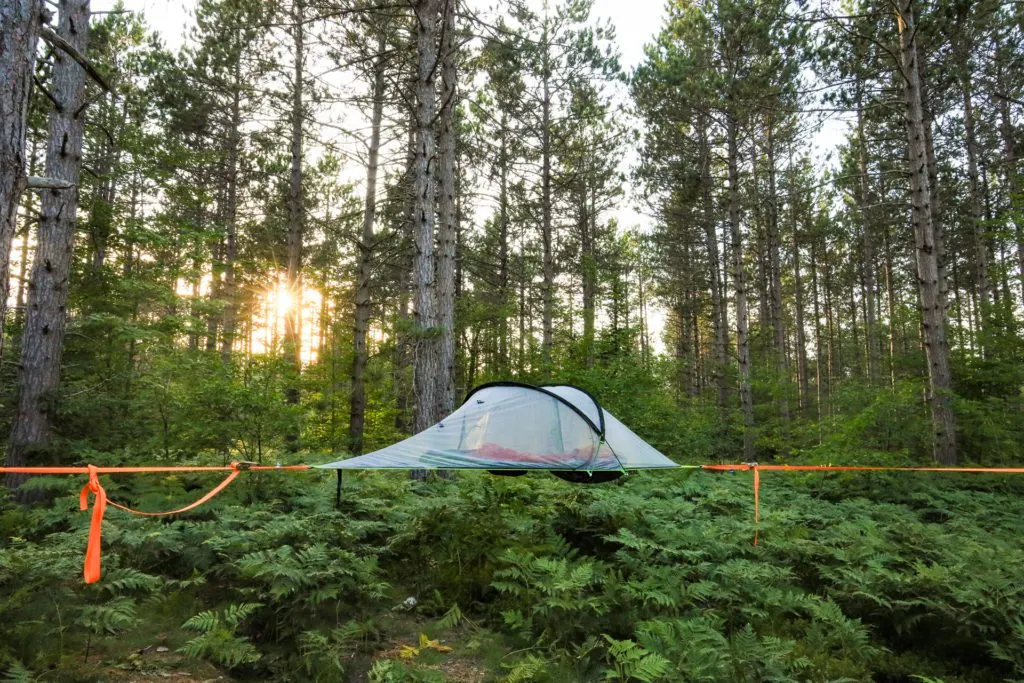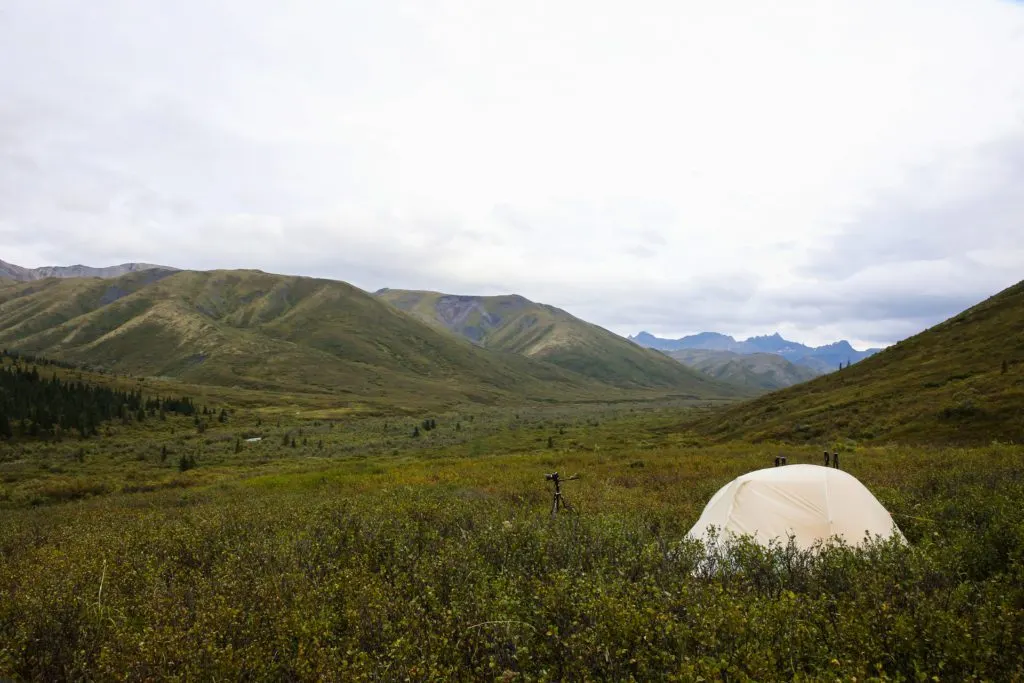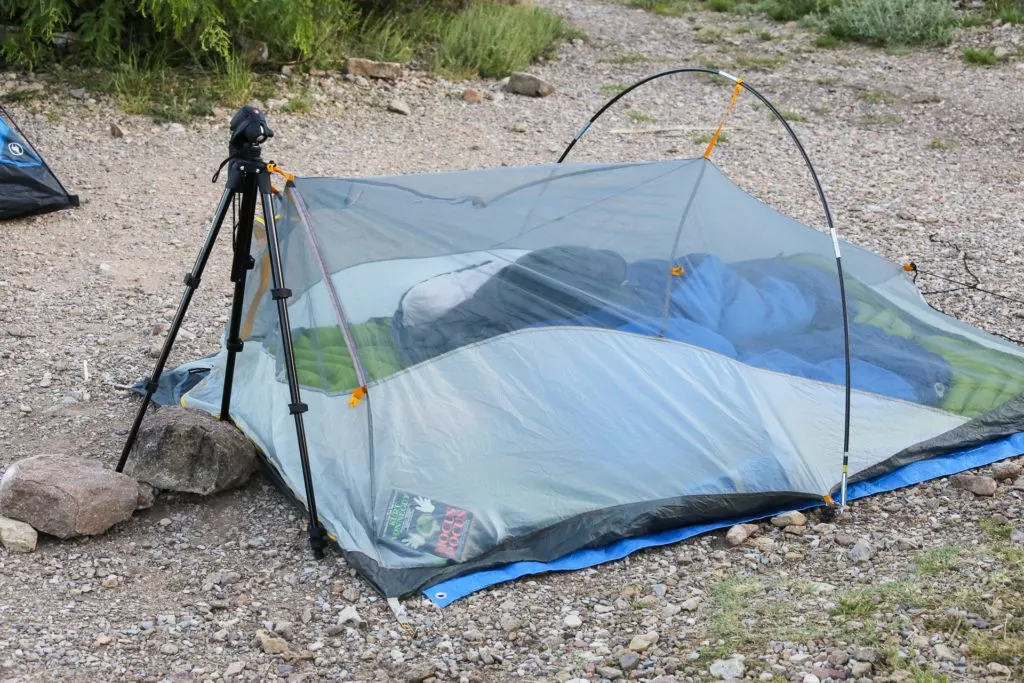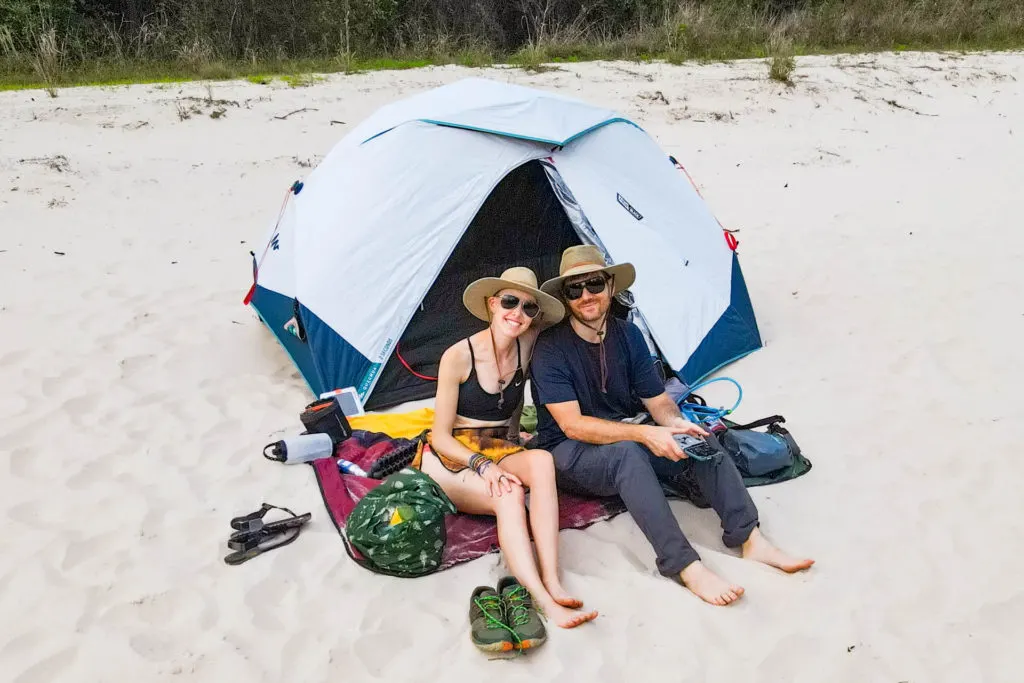The Terradrift giveaway is on! Enter here for a chance to win over $1,000 in outdoor gear!
We all want the perfect campsite every time we pitch our tent: an amazing view, a nice shade tree, safe surroundings, a secluded spot so you can poop in the woods without worrying whether anyone is going to wander past…But finding the perfect site is easier said than done. Fortunately, there are ways to locate just what you want (or need) no matter where you find yourself. So here are our tips for how to find the perfect campsite whether you’re headed deep into the backcountry or setting up at a nearby state park.

How to Find the Perfect Campsite
When it comes to picking the ideal spot to pitch your tent (or hammock), start by assessing your needs, doing some research, and putting an emphasis on safety. Then head outside prepared and enjoy your dang self!
Figure out what you want (or need)
Ask yourself a series of questions in order to find the perfect campsite for you and your trip:
- Do I need electricity?
- Do I want running water?
- Is there a bathroom nearby (or do I even need one)?
- Can I have a fire? If so, is there a fire pit? Will I need to bring wood from nearby or is it available to purchase on-site?
- Is there a grill or some way to cook food or do I need to bring my own?
- Do I want to be close to town or prefer a more secluded campsite?
- Am I able to hike in to a campsite or will I need to drive up?
These questions will help you locate the perfect campsite. Just figure out what you’re looking for, then do some research before you head out to ensure you end up where you want to be. And pay attention to the details, because it’s not a good start to your trip if you arrive and realize you accidentally booked a walk-in campsite and have no way to easily transport gear and have to haul it over a series of hikes back and forth to your car.

Scout Ahead
Once you’ve nailed down what you want in a campsite, time to start searching. If you’re backcountry camping, ask around at local gear shops or at ranger stations to discover where the best campsites are hidden (locals always have the inside scoop).
If you’re more into freedom camping or boondocking, scan websites like freecampsites.net or Campendium.com for dispersed campsites on BLM or public land (we wrote a whole post about dispersed camping here).
And if you’re booking a site in a state or national park, many publish photos on their online booking platforms so you can take a peek at what kind of sites are available. This is handy when trying to locate sites with excellent views or picnic tables, but also great if you are hammock camping and need to know if there enough large trees or whether there’s enough access to sun for the roof-mounted solar panels on your teardrop trailer.
Stay Safe
Of course, views aren’t everything. There’s safety to consider, too. So you’ll definitely want to select a campsite that’s not going to put you in harm’s way. Mostly this pertains to backcountry or dispersed camping as developed campgrounds are usually relatively safe, but a few of these tips apply no matter where you’re setting up camp.
- Don’t pitch your tent directly under tree limbs or near dead trees that could topple. If the wind picks up or there’s an unexpected storm, the last thing you want is a branch or whole tree falling on your tent in the middle of the night.
- If you’re hammock camping, don’t hang your hammock on any trees smaller than 15 inches wide (or that aren’t alive and healthy). Any smaller and you could damage the tree. Or worse, it could topple over on you.
- Consider the possibility of rain. Yes, it will help you decide if you need a rain fly, but rain can also cause flooding. So don’t pitch your tent in a low spot where water can collect or too close to a stream that could swell and rise if there’s a storm.
- Take advantage of large boulders or hills that can function to block the wind so you’re not listening to your nylon snap all night long. This can also help protect your tent from folding in half on extremely windy adventures. Just don’t camp too close to cliffs or hills that could be prone to rock falls.
- Don’t forget about the animals. Don’t camp in a place that looks like it’s a thoroughfare for wildlife. And always store food properly depending on what kind of wildlife live in the area (for example, use a bear safe or locker to store food if bears or even wily rodents can be found nearby).

Come prepared
Once you’ve asked yourself the above questions and assessed what kind of campsite you even want, make sure you arrive prepared (unlike we did in the photo above when we forgot to make sure we brought our tent poles…).
For example, if you want a campfire in the evening but you know you’re not allowed to gather wood and there’s nowhere to buy firewood on-site, make sure you stop in town on the way to the campground and stock up. Same goes for cooking. If you know there’s no grill, make sure you bring a camp stove or food that can be eaten raw. If there’s no electricity but you need power for lanterns or camp accessories, make sure to bring a power source (we love our Goal Zero Yeti 500X and Nomad 50 solar panels for this). And if there’s no running water, make sure you pack plenty for drinking, dishes, cooking, etc.
Also know if there will be a place to dispose of your garbage. A trash bag or two is an easy thing to forget, but neglect to bring one along, especially if there’s not a dumpster or trash can nearby, and you could end up with a backseat or backpack full of candy bar wrappers, or worse, you might be tempted to throw trash in the fire, which is never a good idea (just don’t do it).
So make sure you know where you’re headed, what you need to bring with you, and what amenities will be available once you arrive. Which leads us to our next point…
Leave No Trace
Failing to plan and come prepared means you’re less likely to adhere to Leave No Trace principles, the 10 commandments (well, 7 commandments) of outdoor recreation. Not familiar with Leave No Trace principles? Read up on all 7 here.
When you go camping, make sure you know how to leave as little impact as possible, including how to dispose of trash properly, build a fire safely, and yes, do your business in the woods without leaving any trace that you were ever there to begin with.

Bottom Line
Every camping trip will be different because every campsite will be different. But with these tips and tricks you can have a stellar time and find the perfect campsite almost every time. So get out there, sleep outside, and wander on!
•
This post contains affiliate links, which means if you make a purchase you help support Terradrift! You rock!
Alisha is a freelance outdoor journalist and photographer based in Ogden, UT. She loves backpacking, hiking, mountain biking, kayaking and snowboarding (even though she’s terrible at it). She’s also pretty sure she’s addicted to coffee. alishamcdarris.com
